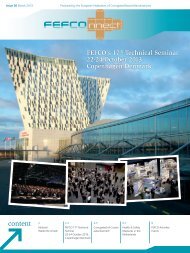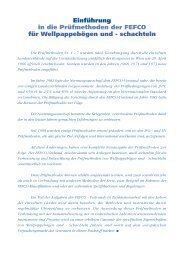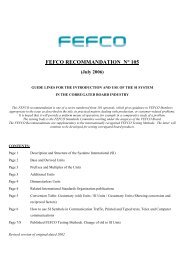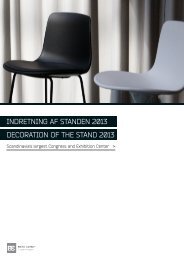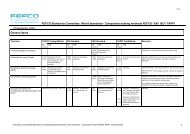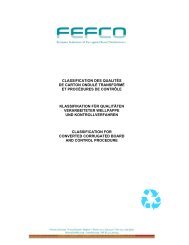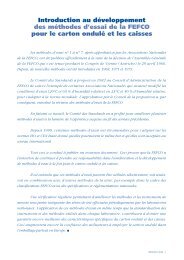Read - Fefco
Read - Fefco
Read - Fefco
Create successful ePaper yourself
Turn your PDF publications into a flip-book with our unique Google optimized e-Paper software.
Inspiring change,<br />
the future for smart sales<br />
& marketing<br />
This presentation was delivered by Alain<br />
Goudsmet sitting second from the right in<br />
the picture, Director of the Mentally Fit Institute<br />
(Brussels, Paris, Breda), coach of the elites<br />
of the Belgian federations of Tennis and Field<br />
Hockey, executive coach and trainer in Human<br />
Development, with more than 20 years of experience<br />
in the field of coaching individuals<br />
and groups under heavy pressure: managers,<br />
employees, athletes.<br />
We can compare the life cycle of human beings<br />
with that of firms: birth, growth, maturity,<br />
development if there is a stimulus for transformation,<br />
then later, decline and death. Disruptions<br />
are necessary in order to develop. The<br />
dynamic of change first published by Prof<br />
Ilya Prigogine (Belgium), Nobel Prize Physics<br />
– 1972, describes four stages of the change<br />
process: Norm, Storm, Transform, Perform, or<br />
6 FEFCOnnect 5 - December 2005<br />
to put it differently: stability, disruption, turning<br />
point, and new trajectory (which is a progression<br />
if the trajectory is better, or a regression<br />
if it is worse). The storm, or disruption is<br />
obviously a zone of discomfort, while the turning<br />
point is a time of awareness.<br />
Corporate storms can be for example acquisitions,<br />
mergers, restructuring, etc..<br />
What are the major factors that influence the<br />
co-workers and the work climate in periods of<br />
‘STORM’ ? The following and in that order:<br />
1. Points of attention, measure and recognition<br />
by the leaders<br />
2. Leaders’ reactions to critical situations<br />
3. Example and advice, given by leaders<br />
4. Recruitment criteria, promotion, retirement<br />
et rupture<br />
5. Ways of social, formal and informal life<br />
6. Usual systems and procedures<br />
Special supplement FEFCO<br />
16th Marketing Congress in<br />
Istanbul<br />
7. Corporate culture and corporate structure<br />
8. Arrangement of physical space / office environment<br />
9. History and myths, linked to persons and<br />
important events<br />
10. Institutional declarations, charters, credo,<br />
ethical codes<br />
The dynamic of change<br />
describes four stages:<br />
Norm, Storm,<br />
Transform, Perform.<br />
How does this apply to firms?<br />
Alain Goudsmet also described the four classic<br />
phases of a corporate storm: Refusal (anger),<br />
Resistance (negotiation), Gathering (joining)<br />
and Energy (new projects). He mentioned<br />
that the company just like a human being<br />
has a set of batteries: mental, emotional and<br />
physical sources of energy. The rule is that we<br />
charge the batteries and then use that energy<br />
to perform.<br />
He concluded that in order to succeed in<br />
our change process we had to keep a clear<br />
mind!<br />
Panel Discussion<br />
A panel discussion followed, moderated by<br />
Paul Hague of B2B international, UK, and involving<br />
Nico Knegt, Miklos Galli, Bob McLellan,<br />
Alain Goudsmet, and Leopoldo Santorroman.<br />
Topics were varied and covered<br />
amongst other things: the increasing skills and<br />
training of the purchasing professionals and<br />
the importance of knowing your customers’<br />
customers needs.



